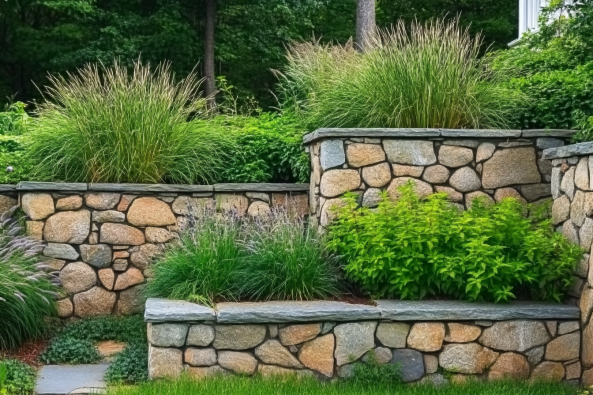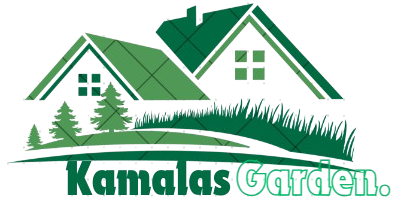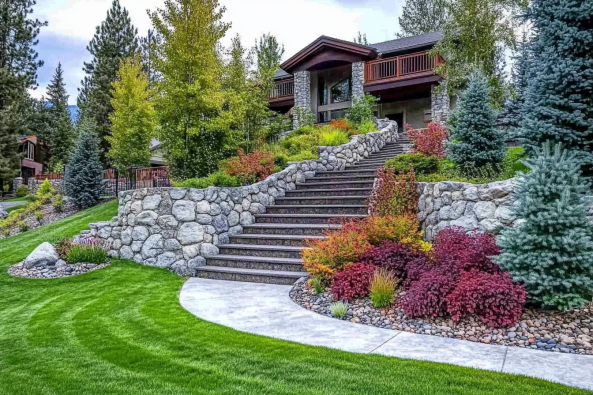Why Landscaping a Sloped Front Yard Can Be Challenging (But Rewarding!)
Landscaping a sloped front yard presents unique challenges but also offers incredible rewards when done right. A well-planned design enhances curb appeal, improves accessibility, and prevents common slope-related issues like erosion and water runoff.
Common Challenges:
- Erosion: Rainwater can wash away soil, exposing roots and destabilizing plants.
- Water Runoff: Water tends to flow quickly down a slope, making moisture retention difficult.
- Accessibility: Slopes can be tricky to navigate without proper pathways and stairs.
Benefits of a Well-Designed Sloped Front Yard:
- Visual Appeal: A multi-level yard adds depth and dimension.
- Improved Drainage: Strategic landscaping helps manage water runoff.
- Functional Space: Terracing and pathways create usable areas.
10 Best Landscaping Ideas for Sloped Front Yards
1. Mulch for Erosion Control
Mulch is a simple and effective solution for preventing soil erosion on slopes.
- How mulch prevents soil erosion: It stabilizes soil, retains moisture, and suppresses weeds.
- Best types of mulch for sloped areas: Shredded bark, pine straw, and wood chips work best as they adhere to the soil.
2. Retaining Walls for Stability & Visual Appeal

Retaining walls add structure, prevent erosion, and enhance the aesthetic of a sloped yard.
- Materials to use: Stone, wood, concrete, and brick offer different aesthetics and durability.
- DIY vs. professional installation: Small walls can be DIY-friendly, but taller structures require expert craftsmanship.
3. Terracing for a Functional & Aesthetic Yard
Creating terraces transforms a steep slope into manageable, flat planting areas.
- Step-by-step guide to creating terraces:
- Measure and plan terrace levels.
- Install retaining structures like wood planks or stone blocks.
- Fill terraces with soil and plants.
- Best plants for terraced gardens: Lavender, daylilies, and creeping phlox.
4. Creating Pathways with Natural Materials
Pathways improve accessibility and add a decorative element to a sloped yard.
- Stone, gravel, and wood pathway ideas:
- Flagstone for a rustic look.
- Gravel for affordability and drainage.
- Wood planks for a natural touch.
- How to ensure stability and prevent shifting:
- Use edging materials to contain the pathway.
- Install a sturdy base with crushed stone or sand.
5. Layered Planting Techniques for Depth & Texture
Layering plants creates a balanced and visually appealing landscape.
- Using ground cover, shrubs, and trees for balance:
- Ground cover: Creeping thyme, ajuga, sedum.
- Shrubs: Boxwood, hydrangea, spirea.
- Trees: Dogwood, Japanese maple.
- Best low-maintenance plants for slopes: Periwinkle, ornamental grasses, juniper.
6. Water Features for a Relaxing Atmosphere
Adding a water feature can make your yard feel like a peaceful retreat.
- Small waterfalls, ponds, and stream ideas:
- A cascading rock waterfall.
- A small pond at the base of the slope.
- A meandering stream to channel water runoff.
- How to control water flow on a slope:
- Use rocks to slow water movement.
- Install an underground drainage system.
7. Hardscaping Elements for a Low-Maintenance Yard
Hardscaping minimizes upkeep and enhances usability.
- Integrating pavers, steps, and edging:
- Paved patios for seating areas.
- Stone steps for easier navigation.
- Edging to define garden beds.
- Blending hardscape with natural greenery: Use climbing plants, decorative grasses, and small shrubs.
8. Drought-Resistant Plant Choices for Sloped Landscapes
Choosing drought-resistant plants ensures your landscape stays lush with minimal watering.
- Best plants for dry, sloped areas: Succulents, Russian sage, ornamental grasses.
- How to reduce watering needs while maintaining beauty:
- Use mulch to retain soil moisture.
- Group plants with similar water needs.
9. Adding Stairways for Safe and Stylish Navigation
Stairways enhance accessibility and add a design element to your yard.
- Materials for durable and aesthetic stairs:
- Stone for a classic look.
- Wood for a natural feel.
- Concrete for longevity.
- Safety tips for non-slip pathways:
- Use textured surfaces to prevent slipping.
- Install railings for extra security.
10. Outdoor Living Spaces for Entertaining & Relaxation

Turn your sloped yard into a functional outdoor oasis.
- Incorporating seating areas, fire pits, and patios:
- Tiered patio spaces for multi-use areas.
- A fire pit for a cozy gathering spot.
- Built-in benches to maximize space.
- How to maximize space on a slope:
- Use retaining walls to carve out flat spaces.
- Arrange furniture strategically to fit the terrain.
Final Tips for Maintaining a Sloped Front Yard Landscape
Preventing Soil Erosion Over Time
- Reapply mulch annually.
- Install erosion control fabrics in highly prone areas.
- Use deep-rooted plants for soil stabilization.
Best Watering Techniques for Sloped Areas
- Use a drip irrigation system for even distribution.
- Water early in the morning to reduce evaporation.
- Install rain gardens to capture runoff naturally.
Seasonal Maintenance Checklist
- Spring: Refresh mulch, prune plants, check retaining walls.
- Summer: Monitor water needs, remove weeds.
- Fall: Plant perennials, rake leaves to prevent buildup.
- Winter: Protect plants with burlap covers, check drainage systems.
Related Articles & Inspiration
Need Expert Advice? Get a Free Landscaping Consultation!
Transform your sloped front yard with expert guidance. Get personalized landscaping tips and find professional services to bring your vision to life.
For more inspiration, check out this external guide: 10 Front Yard Landscaping Ideas on a Slope.
Also, check out our related post on Small Front Yard Landscaping Ideas for additional inspiration.

